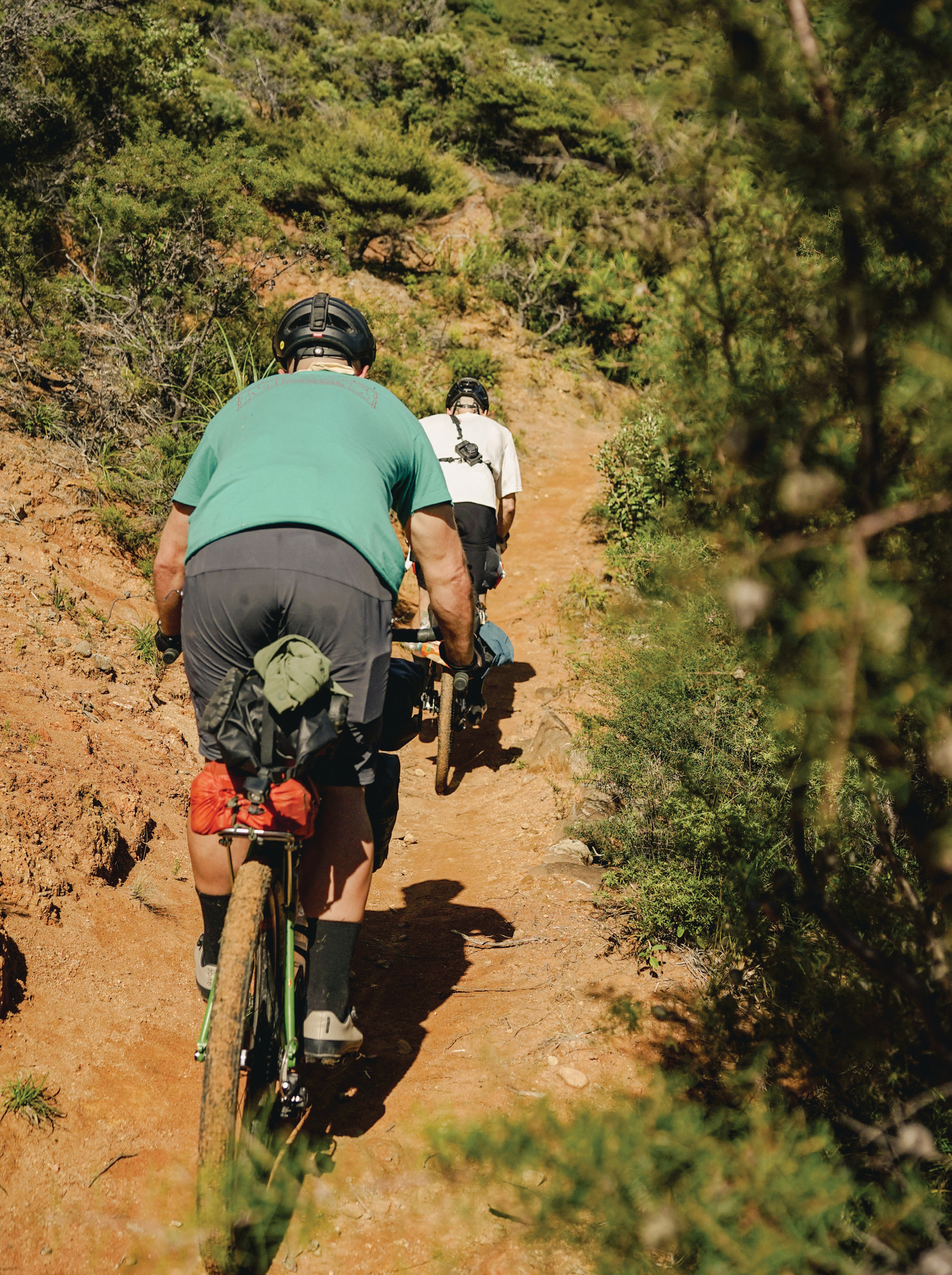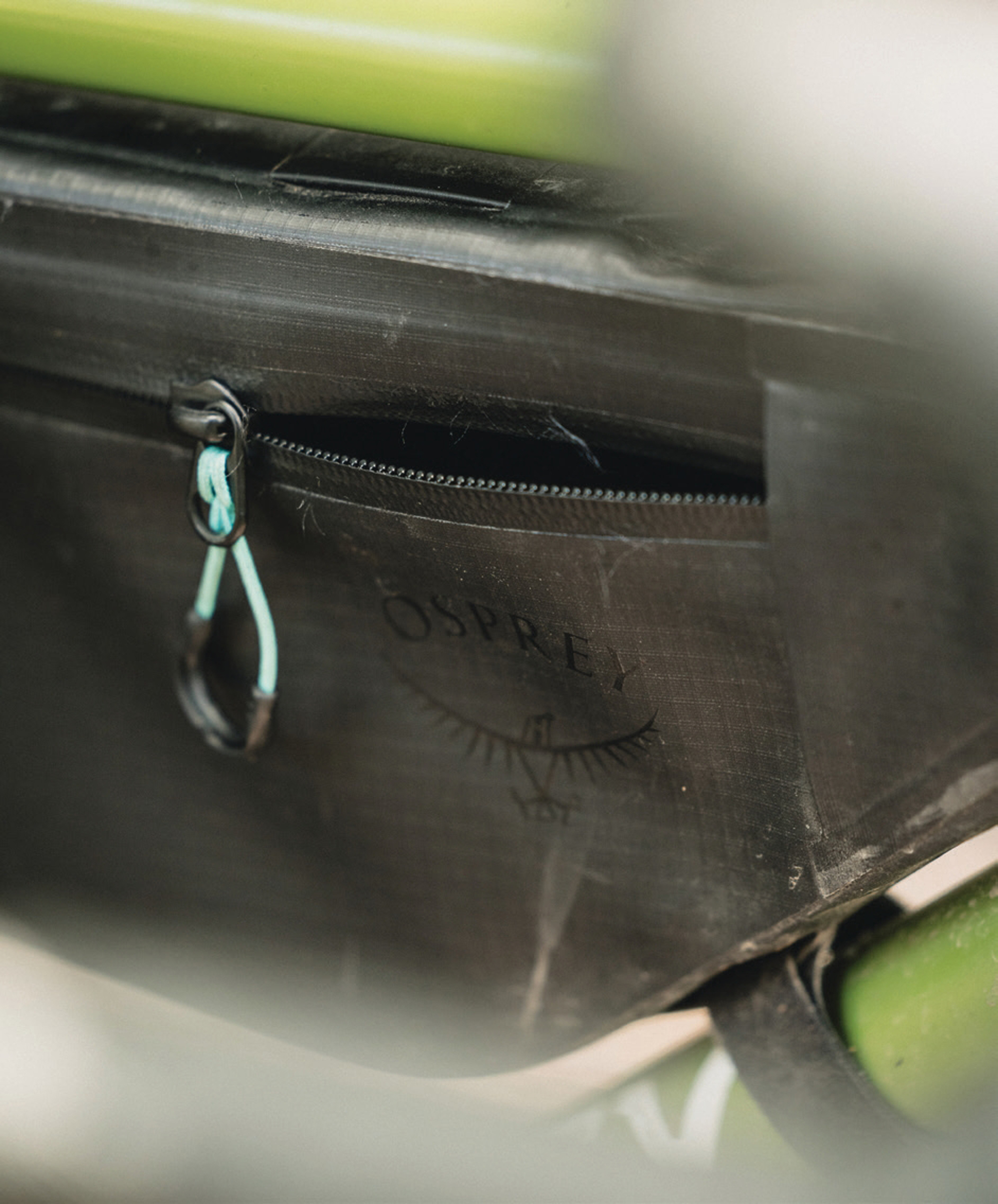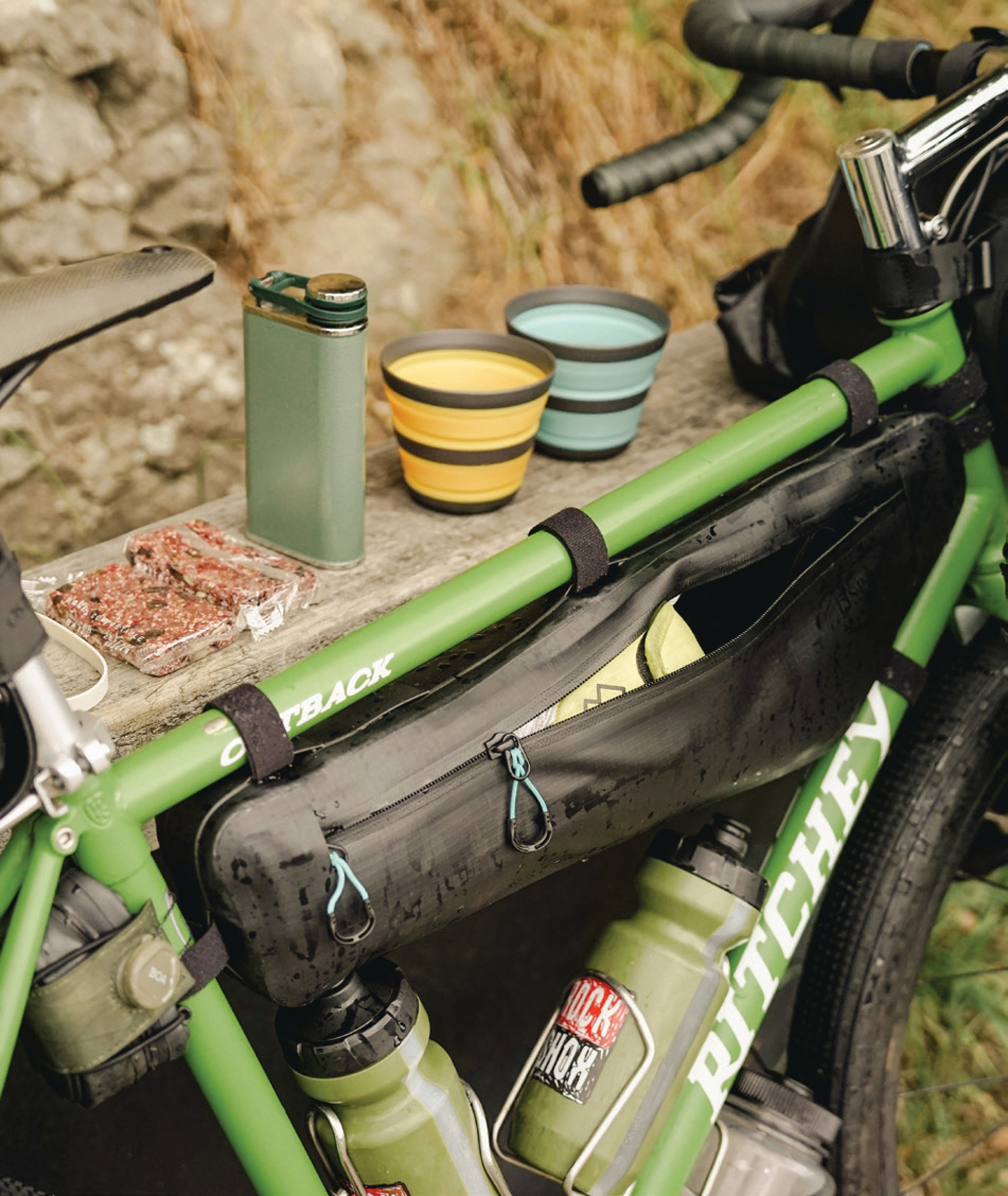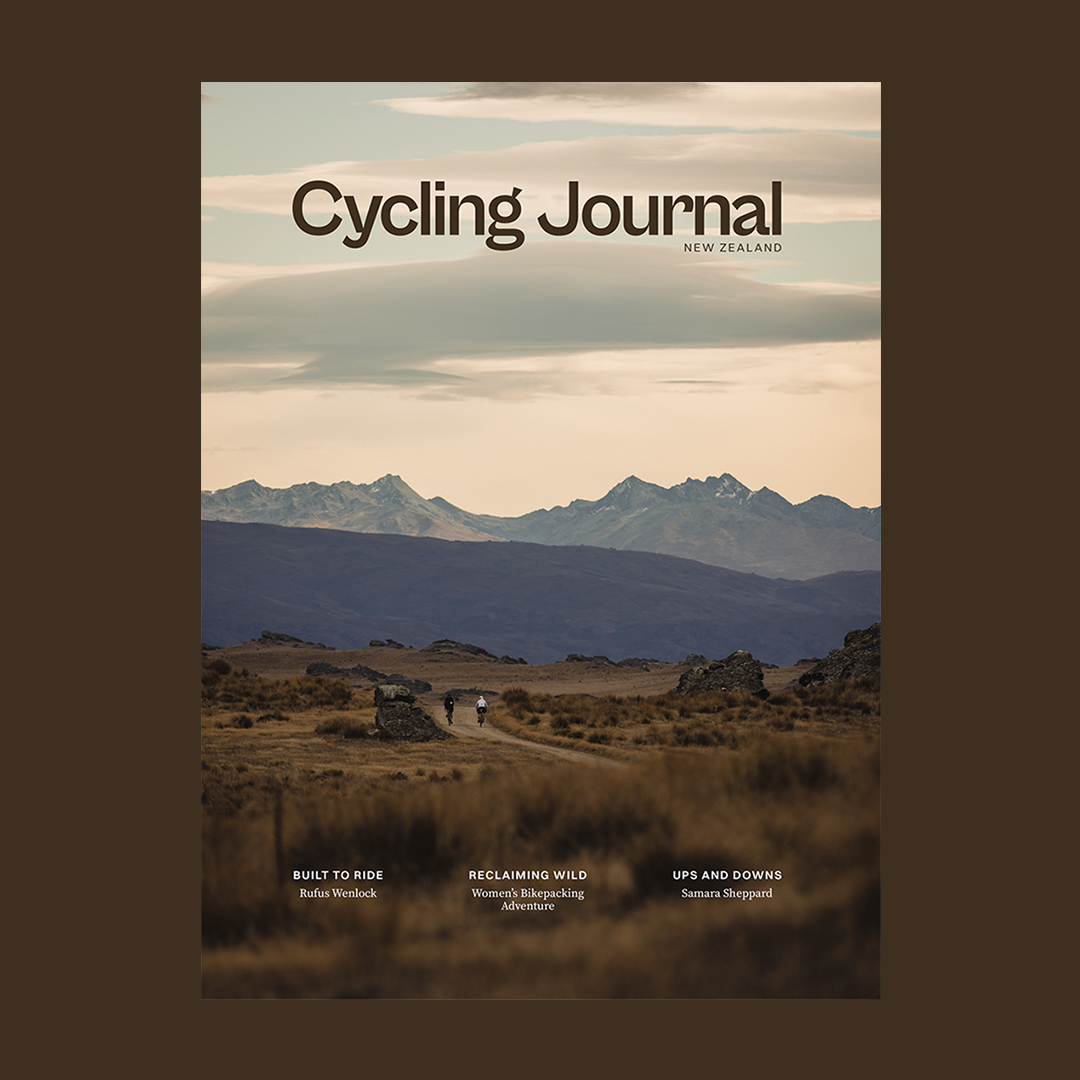Words Liam Friary
Images Cameron Mackenzie and Jakob Lester
RRP Handlebar Bag $239 | Saddle Bag $239 | Frame Bag $149 (small) | $159 (medium) | $169 (large)
Distributor Outdoor Holdings
There’s a plethora of bikepacking bags on the market these days. It clearly shows how this once niche sector has boomed to become more mainstream. However, roots in cycle touring go way back and riding around with your luggage isn’t anything new.
What’s perhaps ‘new’ is the way these bags attach. Bikepacking bags often attach to your bike simply via straps, rather than having racks and panniers – both have their pros and cons. I have used numerous bikepacking bags over the last decade and have had some joy – and pain! – with most of them, so I was interested when Osprey announced they’d be coming to the market with a bikepacking range. Slight detour – we are now seeing large outdoor gear brands moving into this space, which is quite promising because it means more general acceptance of bikepacking in a broader market. The Osprey Escapist series consists of three on-body backpacks and five bike-mounted frame bags: Handlebar Bag, Saddle Bag, Frame Bag, Wedge Bag, and the Top Tube Bag. They all feature waterproof RF-welded construction, are built with 100% recycled nylon fabrics, and come in black. I have been using most of the range over the last six months and put the below products through their paces when we explored Aotea Great Barrier (previous volume).
Osprey Escapist Handlebar Bag
The handlebar bag is one of the most versatile and accessible ways to haul gear on your bike. It doesn’t matter what you ride, there’s always options to carry gear up front. The Escapist Handlebar Bag is made from 100% recycled 210D nylon with DWR treatment; it holds 10L in a waterproof double- ended dry bag. I think both storage and usability in all-weather – especially in our country – matters. I typically use the front bar bag for lighter gear such as sleeping attire so it’s not heavily weighing down the front end of the bike. The handlebar bag easily stashed my sleeping bag, sleeping matt and a down jacket – with space to spare! The storm clouds opened as we crossed the Hauraki Gulf to Aotea – the waterproof fabrics ensured everything was kept dry. I have used the bag since then and it does a very adequate job of staying dry – it’s made up of waterproof fabrics, RF welded seams, and waterproof zippers. I should note, the front bag has got covered air purge holes to vent out pressure which increases compression. I like the feature a lot as it means you can get the bag small, tight and snug with ease.
The dry bag sits in a harness which has an aluminum reinforcement for stability, front reflective compression straps, front gear lash points, a head tube strap, and an additional over-the-stem strap to prevent downward rotation. In practice, the harness works well and – when lashed tightly – stays in place on rugged terrain. The harness itself sits away from the handlebar with small bumpers which allow for better hand positions during rides and means the bags isn’t snagged too closely to your headtube. I like this approach, but think it could do with a bit more refinement – it’s harder to cinch the straps around the handlebar tightly and means they need tightening from time to time on longer rides.
Whilst the system doesn’t set innovation trends, it functions well. I am a fan of the bag and holster – you can release the bag without removing the cradle from the bike. This lets you take the bag off when you get to camp without the hassle of feeding the buckle system through the seat rails in the morning. It’s lightweight, but that depends on what you pack into it. It kept my gear dry in showers and some heavy rain. I think the cinch system around the handlebars could be refined, but that’s only a small gripe. It works well with more drop bar set ups, thanks to the holster system.
Osprey Escapist Saddle Bag
Again, like the handlebar bag, the 9L saddle bag is water resistant with welded seams. It’s made up of 100% recycled 210D nylon with DWR treatment. The removable dry bag is held in place by a fixed holster-style harness. The cradle attaches to the seatpost with a double wrap Velcro strap, and to the saddle rails using two locking webbed straps. I really like this approach with the saddle bag coming out of the harness. This means less faff getting bags on and off the bike every time you camp and de-camp. Believe me, this often takes a bunch of time and can be annoying on multi-day trips if there’s not a separate bag and harness. The saddle bag can be loaded well and carried most of my overnight gear and another day’s riding kit with a ton of room to spare. Like the handlebar bag, the saddle bag has air purge valves to make packing easier. I like getting the bag as small as possible and the air purge really helps that.
When attached to the bike, the holster and bag stay in place. This was the case across roads and trails without tarmac; a reinforced holster with aluminum top and bottom adds to the stability and less bounce and sag. On other bags I have needed to cinch the side straps multiple times on rides, but with the Escapist saddle bag that wasn’t necessary. Once buckled onto the seat rails and seatpost, the cradle conforms very snugly against the underside of the seat, making for a very secure and streamlined attachment. The saddle bag has a low-profile and mounts quite high on the saddle, which is good for tyre clearance. This would make it a solid choice for smaller frames.
Again, there’s an advantage to the cradle system, which you can remove the bag from when you arrive at your digs or camp overnight. Although it sits high even when packed, making any tyre rub or clearance anxiety disappear, it’s perhaps not the most dropper-post friendly bag on the market. That said, the Escapist saddle bag does its job well and is a valuable addition to any bikepacking trip.

Osprey Escapist Frame Bag
For me, the frame bag is perhaps the most important bag. That’s because most of my rides aren’t multi-day bikepacking missions (unfortunately) so the frame bag stays on my bike and gets a lot of use. I always like to have a bag to pack my bike paraphernalia into for day rides, and I often wear more relaxed attire so am not equipped with traditional jersey pockets. Like the rest of the range, the frame bag is water resistant. Again, like its brethren, it’s made up of 100% recycled 210D nylon with DWR treatment. It has a structured exterior, a double-ended zipper on the drive-side, a map pocket on the non-drive-side, water-resistant zippers, and a daisy chain along the spine with a soft anti-scratch hook and loop strap. It comes in three sizes; small, medium and large.
I found the large bag to fit my Ritchey Outback nicely. The frame bag has harder, more structured, sides which keeps it in shape even when not packed with bits and bobs. When packed, it easily consumed anything I’d throw into it – I was astounded by how much room was left. On the bike, the dual double-ended zipper with a daisy chain meant I could easily access contents from within the bike. I have always had a gripe about bags that are difficult to get in and out of whilst on-the-fly, so was stoked about the ease of access with the Escapist frame bag. I like to have everything in its place, so when I’m buckled I know where they are; the left-side organiser panel was good for this purpose. However, I think the drive-side pocket should also have compartments inside it for better gear organisation.
The Escapist frame bag is the most versatile product for me. It’s stayed on my bike for the past six months and is used for long rides, commutes, and everything in between. It has ample storage and when going fully off-grid it can be packed with a lot of camp kit – something I found super handy on our trip to Aotea Great Barrier Island. The sturdiness and the ease of access make it stand out. It could do with a few more organiser compartments, but that’s my only small gripe.





